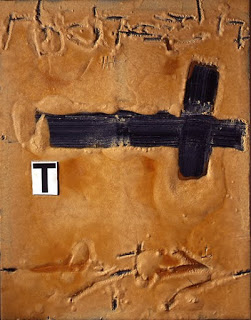Obra Social "La Caixa", the cultural foundationbelonging to the Spanish bank, La Caixa, offers wonderful, often thought-provoking art exhibitions in its different venues throughout Spain. In CaixaForum Palma, in the Balearic Islands, there is an interesting exhibition currently on display, "Crossed Gazes".
It is a selection of works owned by La Caixa Foundation and the MACBA Foundation from Barcelona. Realistic art from the 1950s and 60s is juxtaposed with abstract work from the 1980s and 90s. Theshow uses paintings, some sculpture and photographs to examine how artists saw the world during those decades and how they chose to express what they felt about their realities. There are works by artists as varied as Sigmund Polke and Anselm Kiefer, Joan Miro, Henri Michaux, Antoni Tapies or Philip Guston, Jean Dubuffet or Edouardo Chillida.Many photographs were included, often black and white (Brassai, Robert Frank or Xavier Miserachs for the earlier decades) and in colour, usually of huge format for the later decades (Andreas Gursky, Hiroshi Sugimoto or Thomas Struth amongst others).
I personally found the title of the exhibition a little ironic, as my reactions to the art, as I walked through the rooms, were those of someone with a personal set of "crossed gazes". It so happened that the previous day, I had spent a magical day by myself in the countryside, working plein air, drawing and marvelling at the complex, expansive beauty of the countryside and the amazing abstractions within the natural world around me. Abstractions of form in trees and their bark, the lay of the land, types of stones and their patterns – things which I found fascinating to observe.
Consequently, when I walked into the CaixaForum exhibition the following day and began to look hard at the works of art on display, I found myself getting almost claustrophobic. The massive paintings of the 80s and 90s, the Kiefer, the Miquel Barcelo or the one by Juan Usle, bore down on me in a way I had not expected - they seemed airless and pretentious. This surprised me as I usually find that particularly Barcelo's and Anselm Kiefer's work interest and often move me. My reaction made me realise afresh that large paintings are not my favourite format - I relate far more comfortably to work of "human" size, works that are more intimate and draw one in to a closer look. I think that we have been, and still are, living in an era when public spaces have required huge works of art, and somehow the intensity of such work is diluted and lost. My personal gaze finds that art on a smaller scale is often a far greater test of quality and veracity - bombast can cover a lot of sins, verbally or in art.
My disappointment - at myself especially - continued when I went on to the rooms covering the 50s and 60s. There, the art was indeed of a more human scale, often quite small in size. The photographs were full of impact, and also of historic interest, of course. Nonetheless, the abstract art seemed a little disassociated from anything that I could relate to today; gone - thankfully - is the angst that the aftermath of the Spanish Civil War and the Second World War generated in artists who were striving to distance themselves from those particular awful realities. There was, nonetheless, a feeling of almost desperate creativity in the work that seemed almost forced, a "we have got to do something totally different from anything done before" feeling. In a way, that is always a sub-text of each decade in the art world - we all strive to be different and innovative. However, the overall effect of my "crossed gazes" was somewhat depressing in that all these talented artists' works were just not "talking to me" that day!
Philip Guston, Untitled (1968). and Tower (1968)
Philip Guston,
Yet there were truths in some of the work that resonate constantly. One commentary, of three 1967 ink on paper drawings by Philip Guston - Mark, Edge and Horizon, interested me. They were very minimalist lines on paper, like the ones illustrated above, to some extent. However, the curator's commentary for them ran as follows (in Spanish and a mixture with my English translation):
La materia misma de la pintura - su pigmento y su espacio - se resiste mucho a la voluntad, se siente muy poco inclinado a reafirmar su plano y permanecer inmovil. La pintura parece una imposibilidad, solamente con un signo de su propria luz de vez en cuando. Lo cual seguramente se debe al estrecho pasaje entre el diagramar y ese otro estado, la corporeidad. En este sentido, pintar es poseer, mas que imaginar.
The very essence of painting - its pigment and space - is so resistant to the will, so inclined to assert its plane and remain still. Painting seems an impossibility, with only a sign now and then of its own light. Which must be because of the short passage from being a diagram to that other state - taking physical shape. In this sense, to paint is to possess rather than to imagine.
Concepts to ponder as I sort out my gaze from the "Crossed Gazes" of the exhibition. Perhaps it means a return visit to the CaixaForum!


